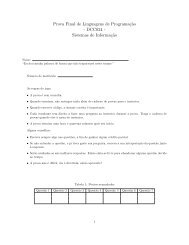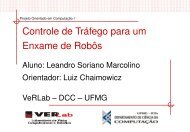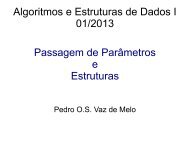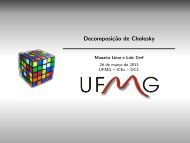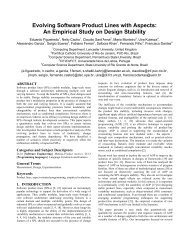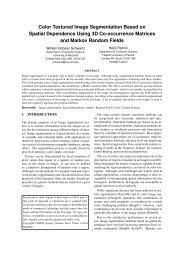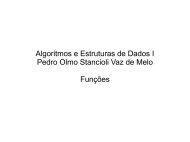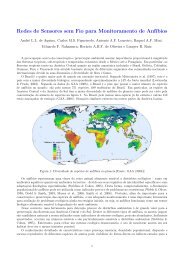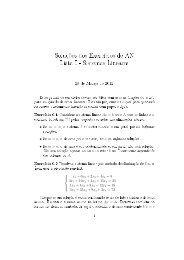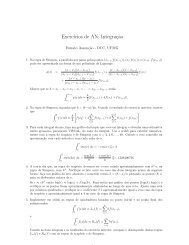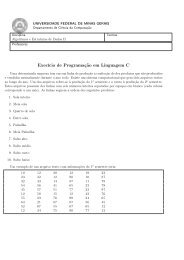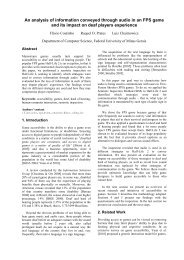A Geographical Analysis of Knowledge Production ... - ResearchGate
A Geographical Analysis of Knowledge Production ... - ResearchGate
A Geographical Analysis of Knowledge Production ... - ResearchGate
Create successful ePaper yourself
Turn your PDF publications into a flip-book with our unique Google optimized e-Paper software.
Cumulative Number <strong>of</strong> Edges<br />
18000<br />
16000<br />
14000<br />
12000<br />
10000<br />
8000<br />
6000<br />
4000<br />
2000<br />
Computer Architecture<br />
Databases<br />
Bioinformatics<br />
Geoinformatics<br />
0<br />
1994 1996 1998 2000<br />
Time (years)<br />
2002 2004 2006<br />
Figure 12: Cumulative Number <strong>of</strong> Edges per Sub-<br />
Area in the Period<br />
subfields: the Computer Architecture and Databases subfields<br />
show a slight increase in the clustering coefficient measure<br />
with time, while the Bioinformatics and Geoinformatics<br />
subfields have a much faster increase. Moreover, the increase<br />
in the measure indicates a process <strong>of</strong> densification <strong>of</strong><br />
these subfields, in which more edges are being inserted into<br />
their networks. This increase contrasts with the decrease observed<br />
in the clustering coefficient <strong>of</strong> networks which involve<br />
all subfields (see Figure 9).<br />
Clustering Coefficient<br />
1<br />
0.8<br />
0.6<br />
0.4<br />
0.2<br />
Computer Architecture<br />
Databases<br />
Bioinformatics<br />
Geoinformatics<br />
0<br />
1994 1996 1998 2000<br />
Time (years)<br />
2002 2004 2006<br />
Figure 13: Clustering Coefficient per Field in the<br />
Period<br />
Figure 14 displays the average number <strong>of</strong> subfields in which<br />
each author publishes in a given single year. These values<br />
are not cumulative over time. The graph shows clearly a<br />
trend <strong>of</strong> diversification, i.e., an increase in the number <strong>of</strong><br />
subfields per author over time. Furthermore, in general, the<br />
number <strong>of</strong> subfields per author is larger for the Ca-US network<br />
and smaller for the Br network.<br />
6. MAPPING COMPUTER SCIENCE SUB-<br />
FIELDS<br />
Number <strong>of</strong> Fields per Author<br />
2.8<br />
2.6<br />
2.4<br />
2.2<br />
2<br />
1.8<br />
1.6<br />
1.4<br />
Br<br />
Ca-US<br />
Fr-Sw-UK<br />
1.2<br />
1994 1996 1998 2000<br />
Time (years)<br />
2002 2004 2006<br />
Figure 14: Average Number <strong>of</strong> Fields per Author for<br />
Br, Ca-US and Fr-Sw-UK Networks for Each Year<br />
In the final part <strong>of</strong> our study we analyzed the interrelationship<br />
between Computer Science subfields. If we consider<br />
a subfield as a set <strong>of</strong> authors who publish in it, the proximity<br />
between subfield A and subfield B can be computed as<br />
follows:<br />
PAB = |R X AB|<br />
|RAK| + |R X AB|<br />
K<br />
K<br />
|RBK|<br />
Lets define the union <strong>of</strong> the edges incident to elements<br />
<strong>of</strong> A as I(A). Then, RAB is the intersection between I(A)<br />
and I(B). Intuitively, the first part <strong>of</strong> the addition is the<br />
fraction <strong>of</strong> external relationships <strong>of</strong> A which involves B, and<br />
the second part is the fraction <strong>of</strong> external relationships <strong>of</strong> B<br />
which involves A. We excluded all edges with PAB < 0.08.<br />
We used the algorithm described in [7] and implemented in<br />
Pajek 10 for the generation <strong>of</strong> a graph for visualization <strong>of</strong> the<br />
interrelationships. The vertices represent Computer Science<br />
subfields, edges represent relationships between them, and<br />
the edge weights are computed using the proximity function<br />
between fields, P.<br />
Figure 15 presents the interrelationship among the 30 subfields<br />
considered. The size <strong>of</strong> the vertices is an indication <strong>of</strong><br />
the number <strong>of</strong> authors in the community representing each<br />
subfield. The smallest community is Geoinformatics, with<br />
177 authors, and the largest is Computer Architecture, with<br />
5,239 authors. The distance between vertices denotes the intensity<br />
<strong>of</strong> the inter-relationship among subfields. Notice that<br />
there is a clear division <strong>of</strong> the graph into two sets <strong>of</strong> subfields.<br />
For example, the upper part <strong>of</strong> the figure displays subfields<br />
related to Computer Systems, such as Computer Networks,<br />
Computer Architecture, and Operating Systems. S<strong>of</strong>tware<br />
Engineering and Algorithms and Theory also belong to this<br />
group. In turn, the bottom part <strong>of</strong> the figure shows subfields<br />
which are closely related to Databases, such as Web, Hypermedia<br />
and Multimedia, Information Retrieval, Data Mining,<br />
and Information Systems. It also includes subfields related<br />
to Artificial Intelligence, Computer Graphics and Computer<br />
Vision.<br />
10 Pajek − Program for Large Network <strong>Analysis</strong>.



